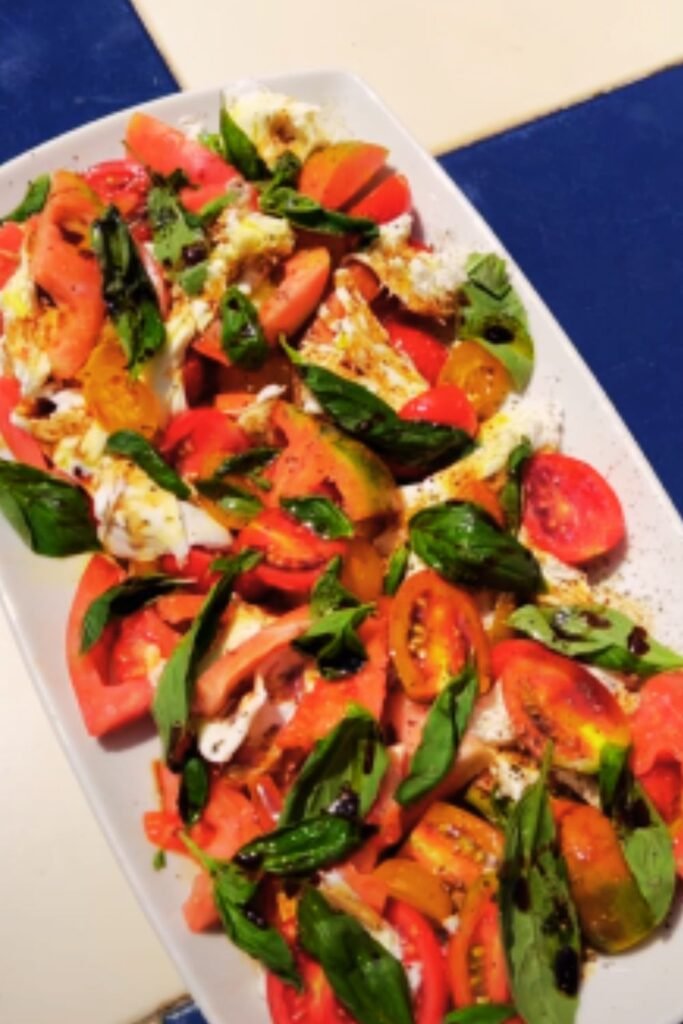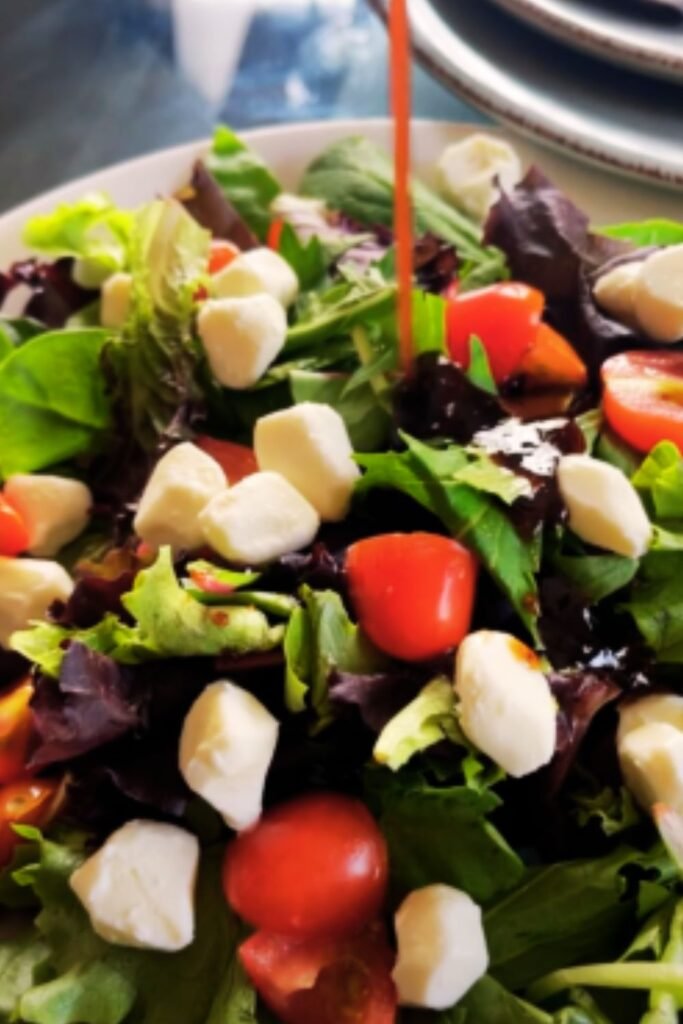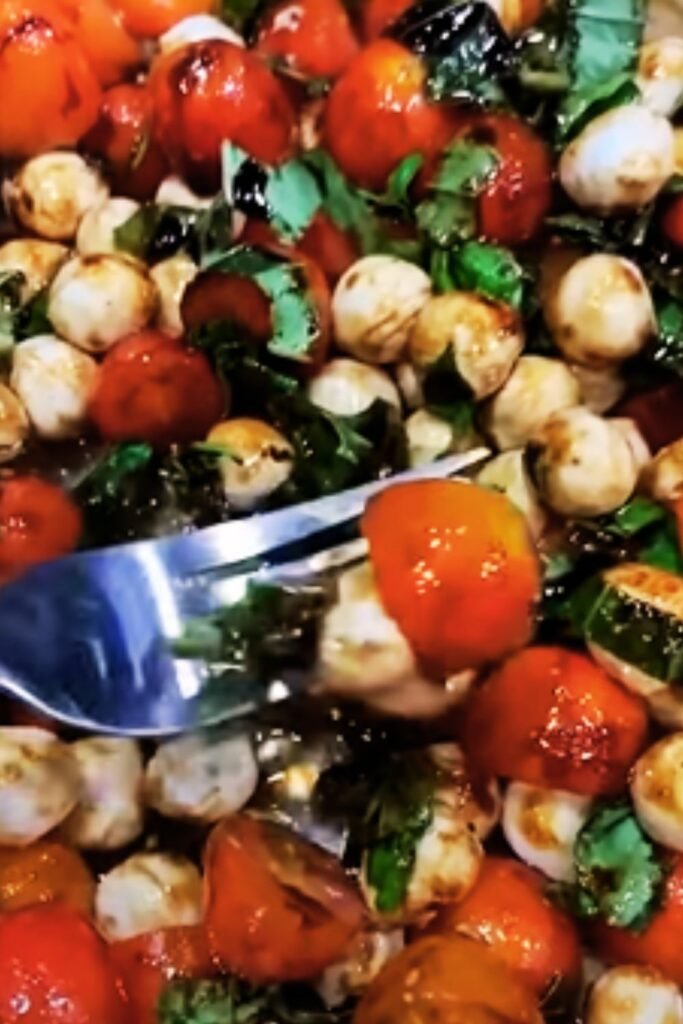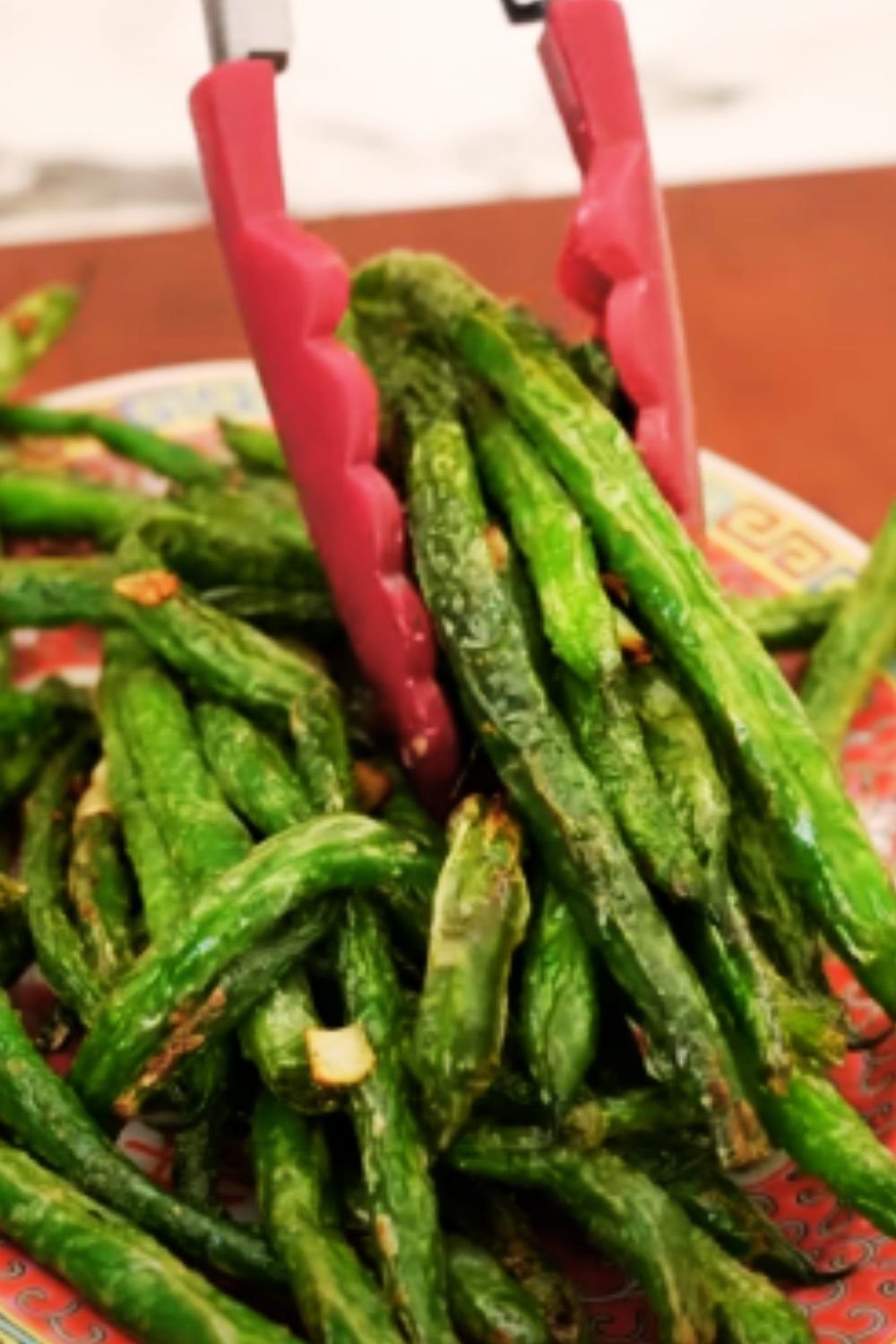Have you ever tasted something so simple yet so extraordinary that it transported you to another place entirely? That’s what happens when I bite into a perfect Caprese salad. The combination of juicy tomatoes, creamy mozzarella, and fragrant basil creates a symphony of flavors that captures the essence of Italian cuisine in its purest form.
I first discovered Caprese salad during a trip to Italy’s Amalfi Coast. Sitting at a small seaside restaurant in Positano, I watched as the server placed before me a colorful arrangement of red, white, and green – the colors of the Italian flag represented through food. That first bite changed my perspective on what simplicity in cooking could achieve.
Today, I’m sharing my comprehensive guide to creating the perfect Caprese salad at home. This isn’t just a recipe; it’s an exploration of quality ingredients, thoughtful preparation, and the rich cultural heritage behind this iconic Italian dish.
The History and Heritage of Caprese Salad
Caprese salad, or “Insalata Caprese” in Italian, originates from the Island of Capri, located in the Tyrrhenian Sea off the Sorrentine Peninsula. The salad’s name literally means “salad of Capri.” While its exact origins are somewhat disputed, most food historians agree that it emerged in the early 20th century.
Legend has it that the salad was created as a patriotic tribute to Italy, featuring the three colors of the Italian flag: red tomatoes, white mozzarella, and green basil. It gained popularity after being served to King Farouk of Egypt during a visit to Capri in the 1950s.
What makes Caprese salad particularly special is how it embodies the Mediterranean philosophy of cooking – using few, high-quality ingredients and letting their natural flavors shine. This principle of simplicity lies at the heart of many beloved Italian dishes.
Essential Ingredients: The Building Blocks of Perfect Caprese
The beauty of Caprese salad lies in its simplicity, which means the quality of each ingredient matters tremendously. Here’s a detailed breakdown of what you’ll need:
Tomatoes: The Foundation
Definition List:
- Heirloom Tomatoes: Older varieties passed down through generations, known for diverse flavors and colors
- Beefsteak Tomatoes: Large, meaty tomatoes with a high flesh-to-seed ratio
- Campari Tomatoes: Medium-sized with excellent sweetness and low acidity
- Vine-Ripened Tomatoes: Tomatoes allowed to ripen naturally on the vine for maximum flavor
When selecting tomatoes for Caprese salad, I look for specimens that are perfectly ripe – firm but yielding slightly to gentle pressure. They should feel heavy for their size (indicating high water content and juiciness) and emit a sweet, earthy aroma at the stem end.
The best tomatoes for Caprese are those that have never been refrigerated, as cold temperatures diminish their flavor and alter their texture. If possible, source your tomatoes from local farmers’ markets during summer months when they’re in peak season.
Mozzarella: The Creamy Heart
Definition List:
- Mozzarella di Bufala Campana: Protected designation of origin cheese made from water buffalo milk in specific regions of Italy
- Fior di Latte: Cow’s milk mozzarella with a delicate flavor and soft texture
- Bocconcini: Small, egg-sized balls of mozzarella
- Burrata: Mozzarella filled with cream and stracciatella (cheese curds), offering an extra rich center
Traditional Caprese salad uses fresh mozzarella, which bears little resemblance to the processed, low-moisture variety used for pizza. Fresh mozzarella should be milky white, extremely tender, and slightly sweet with a subtle tang.
I prefer to use mozzarella di bufala for its superior richness and complex flavor profile, but high-quality fior di latte also works beautifully. Whatever you choose, bring the cheese to room temperature before serving to maximize its flavor and texture.
Basil: The Aromatic Element
Definition List:
- Sweet Basil (Genovese): The classic variety with bright flavor and aromatic qualities
- Purple Basil: Adds visual interest with similar flavor to sweet basil
- Lemon Basil: Offers citrus notes that can complement the tomatoes
- Thai Basil: Not traditional but provides interesting anise notes for an experimental version
Fresh basil should have vibrant green leaves without any black spots or wilting. The aroma should be potent and sweet when you rub a leaf between your fingers.
I always look for basil with the roots still attached or grow my own. Store-bought cut basil often deteriorates quickly. For Caprese salad, larger leaves are preferable as they make a more impressive visual presentation and provide a more substantial herbal presence in each bite.
Olive Oil: The Binding Element
Definition List:
- Extra Virgin Olive Oil: First cold press of olives, unrefined, with acidity less than 0.8%
- Single Estate Oils: Produced from olives grown on a single farm, offering distinctive flavor profiles
- DOP/PDO Certified Oils: Protected designation oils that meet strict quality standards
- Cold-Pressed: Oil extracted without heat, preserving flavor compounds and antioxidants
The olive oil you select for Caprese salad will significantly impact the final flavor. I recommend using only high-quality extra virgin olive oil, preferably one with a fruity profile that complements rather than overwhelms the other ingredients.
A proper Italian olive oil should have a peppery finish that catches slightly at the back of your throat – a sign of healthy polyphenol content. Reserve your most expensive, premium olive oil for drizzling over the finished salad, where its nuanced flavors can be fully appreciated.
Additional Ingredients: The Supporting Cast
Definition List:
- Flaky Sea Salt: Provides texture and concentrated bursts of saltiness
- Black Pepper: Freshly ground for aromatic heat
- Balsamic Vinegar/Glaze: Offers sweet-tart complexity (traditional in some regions, contested in others)
- Oregano: Sometimes used in variations, particularly in southern Italy
While purists might argue that true Caprese needs nothing beyond the core ingredients, thoughtful additions can enhance the experience. Flaky sea salt such as Maldon or fleur de sel adds both flavor and textural interest. Freshly ground black pepper provides gentle heat that balances the sweetness of ripe tomatoes.
Balsamic vinegar or glaze is a somewhat controversial addition. In many parts of Italy, particularly near Capri itself, it would be considered unnecessary. However, a high-quality, aged balsamic can add delightful complexity when used with restraint.
Preparing the Perfect Caprese Salad: A Step-by-Step Guide

Now that we understand our ingredients, let’s walk through the preparation process in detail:
Preparation Steps:
- Bring all ingredients to room temperature (at least 30 minutes out of refrigeration)
- Gently wash and thoroughly dry tomatoes and basil
- Slice tomatoes to approximately 1/4-inch thickness
- Slice or tear mozzarella to similar thickness as tomatoes
- Arrange components on a serving platter
- Drizzle with olive oil
- Season with salt and pepper
- Add any optional elements like balsamic
- Serve immediately for best flavor and texture
Temperature Considerations
The temperature of your ingredients plays a crucial role in the final flavor of your Caprese salad. Cold suppresses flavor, which is why store-bought tomatoes often taste bland – they’ve been refrigerated during shipping and storage.
I make it a practice to set out all my ingredients at least 30 minutes before assembling the salad. This allows the tomatoes and cheese to reach room temperature, which significantly enhances their flavor profiles and aromas.
Cutting Techniques
How you cut your ingredients affects both presentation and eating experience. For tomatoes, I use a sharp serrated knife to create clean slices without crushing the flesh or losing juices. Aim for slices about 1/4-inch thick – thin enough to be delicate but substantial enough to stand up to the cheese.
For mozzarella, you have options. A sharp knife will give you clean, precise slices. However, I sometimes prefer to gently tear the cheese by hand, which creates more textural interest and rustic appearance. The rough edges also capture more olive oil and seasonings.
Basil can be left whole (traditional), torn (for rustic presentation), or chiffonaded (cut into thin ribbons). I generally prefer whole leaves for their visual impact, but there’s no wrong approach.
Assembly Approaches
There are several ways to assemble a Caprese salad:
Stacked Presentation:
- Place a tomato slice on the plate
- Top with a slice of mozzarella
- Add a basil leaf
- Repeat to create individual stacks
- Drizzle with olive oil and season
Layered Presentation:
- Arrange alternating slices of tomato and mozzarella in a circular or linear pattern
- Tuck basil leaves between the slices
- Drizzle with olive oil and season
Scattered Presentation:
- Arrange tomato and mozzarella pieces more casually on a plate
- Scatter torn basil throughout
- Drizzle with olive oil and season
I tend to prefer the layered presentation for its visual appeal and ease of serving. The overlapping arrangement allows guests to take precisely what they want while maintaining the integrity of the dish.
Caprese Variations: Traditional and Modern Interpretations
While I believe the classic Caprese salad needs no improvement, there are several variations worth exploring:
Caprese Skewers:
- Thread cherry tomatoes, small mozzarella balls, and basil leaves onto cocktail skewers
- Drizzle with olive oil or serve with a dipping sauce
- Perfect for cocktail parties and appetizer spreads
Caprese Sandwich:
- Layer the traditional ingredients between slices of crusty Italian bread
- Add a thin spread of pesto for extra basil flavor
- Ideal for picnics and packed lunches
Watermelon Caprese:
- Substitute watermelon for some or all of the tomatoes
- The sweet-savory contrast creates an interesting summer variation
- Particularly refreshing during hot weather
Avocado Caprese:
- Add slices of ripe avocado to the traditional arrangement
- The creamy texture complements the mozzarella while adding richness
- A contemporary twist that respects the original flavor profile
While these variations can be delicious, I encourage you to master the classic version first. Understanding the balance of flavors in the original prepares you to make thoughtful adaptations that enhance rather than distract from the essence of the dish.
Nutritional Profile: Health Benefits of Caprese Salad
One of the reasons I love serving Caprese salad is its impressive nutritional profile. Here’s a detailed breakdown of the nutritional value and health benefits:
| Ingredient | Key Nutrients | Health Benefits |
|---|---|---|
| Tomatoes | Lycopene, Vitamins A & C, Potassium | Antioxidant protection, heart health, reduced cancer risk |
| Mozzarella | Protein, Calcium, Vitamin B12, Probiotics | Bone health, muscle maintenance, gut health |
| Basil | Vitamin K, Manganese, Antioxidants | Anti-inflammatory, antibacterial properties, stress reduction |
| Olive Oil | Monounsaturated Fats, Vitamin E, Polyphenols | Heart health, reduced inflammation, skin health |
A typical serving of Caprese salad (approximately 1 cup) contains:
| Nutrient | Amount | % Daily Value* |
|---|---|---|
| Calories | 260-280 | – |
| Protein | 13-15g | 26-30% |
| Fat | 20-22g | 25-28% |
| Carbohydrates | 8-10g | 3-4% |
| Fiber | 2-3g | 7-12% |
| Calcium | 350-400mg | 35-40% |
| Vitamin C | 20-25mg | 22-28% |
| Vitamin A | 800-1000 IU | 16-20% |
*Based on a 2,000 calorie diet
What makes Caprese particularly notable from a nutritional standpoint is how the ingredients work synergistically. For example, the fat in the olive oil and cheese helps your body absorb the fat-soluble nutrients in the tomatoes, such as lycopene. This makes Caprese salad not just delicious but also a nutritionally intelligent combination.
Serving Suggestions: Complementary Pairings

A Caprese salad can stand alone as a light meal, particularly during hot summer days when appetites tend to be lighter. However, it also pairs beautifully with other dishes as part of a larger meal. Here are some of my favorite pairings:
As a Starter:
- Served before grilled fish or seafood
- Preceding pasta dishes, particularly those with light sauces
- As part of an antipasti spread alongside olives, cured meats, and crusty bread
As a Side Dish:
- Accompanying grilled chicken or steak
- Alongside roasted vegetables for a vegetarian meal
- With simply prepared seafood such as grilled shrimp or scallops
Bread Pairings:
- Crusty Italian bread or ciabatta
- Garlic rubbed crostini
- Focaccia with herbs and sea salt
Complementary Flavors:
- Prosciutto di Parma (for non-vegetarians)
- Marinated artichoke hearts
- Grilled eggplant or zucchini
- Toasted pine nuts for textural contrast
When serving Caprese as part of a larger Italian meal, consider its placement in the traditional course structure. In Italy, it would typically be served as an antipasto (before the pasta) or as a contorno (side dish) alongside a second course of meat or fish.
Seasonal Considerations: When to Serve Caprese
While technically you can make Caprese salad year-round, there’s a significant difference in quality depending on when you prepare it. I firmly believe that Caprese salad is fundamentally a summer dish, best made during the height of tomato season.
In most parts of the Northern Hemisphere, this means July through September, when locally grown tomatoes are at their peak of ripeness and flavor. During these months, farmers’ markets overflow with heirloom varieties that offer complex flavors impossible to find in supermarket tomatoes shipped from distant growing regions.
If you must make Caprese outside of tomato season, look for greenhouse-grown or vine-ripened varieties, which tend to offer better flavor than standard hothouse tomatoes. Cherry or grape tomatoes sometimes have acceptable flavor year-round and can be substituted in an emergency.
Common Mistakes to Avoid: Pitfalls in Caprese Preparation
Even with such a simple dish, there are several common errors that can diminish the final result:
Mistake #1: Using refrigerated tomatoes
Solution: Always allow tomatoes to come to room temperature before using them in Caprese salad.
Mistake #2: Selecting the wrong mozzarella
Solution: Use only fresh, high-moisture mozzarella specifically designed for eating fresh (not cooking).
Mistake #3: Overdressing the salad
Solution: Apply olive oil with restraint – it should enhance, not drown the other flavors.
Mistake #4: Adding too many non-traditional ingredients
Solution: Exercise restraint with additions; each element should have a purpose.
Mistake #5: Preparing too far in advance
Solution: Assemble Caprese just before serving to prevent wilting basil and watery tomatoes.
Mistake #6: Using old or improperly stored basil
Solution: Select fresh, aromatic basil and handle gently to prevent bruising and blackening.
Mistake #7: Under-seasoning
Solution: Don’t forget the salt! It brings out the flavors of the tomatoes and cheese.
Flavor Pairing Science: Why Caprese Works

As someone fascinated by the science of cooking, I find Caprese salad particularly interesting because it exemplifies perfect flavor pairing. Here’s why these ingredients work so harmoniously together:
Complementary Flavor Compounds: Tomatoes and basil share several flavor compounds, creating what food scientists call “flavor bridges.” This chemical similarity explains why they naturally enhance each other.
Balanced Mouthfeel: The juicy acidity of tomatoes contrasts with the creamy richness of mozzarella, creating a balanced mouthfeel that prevents palate fatigue.
Complete Taste Profile: Caprese hits all major taste receptors:
- Sweet (ripe tomatoes)
- Sour/acid (tomatoes)
- Salt (mozzarella and added salt)
- Umami (tomatoes and aged balsamic if used)
- Fat perception (mozzarella and olive oil)
This completeness makes each bite deeply satisfying from a sensory perspective.
Aromatic Complexity: The volatile compounds in basil add aromatic complexity that engages our sense of smell, which comprises approximately 80% of what we perceive as flavor.
Understanding these principles can help you make informed adjustments to the recipe while maintaining its fundamental appeal.
Frequently Asked Questions
Q: Can I make Caprese salad ahead of time?
While you can prepare the components ahead of time (slicing tomatoes and mozzarella), I don’t recommend assembling the complete salad more than 15-20 minutes before serving. The salt draws moisture from the tomatoes, and basil will wilt when in contact with olive oil for extended periods.
Q: Is it authentic to use balsamic vinegar on Caprese salad?
This is a subject of debate among Italian food purists. Traditional Caprese from Capri typically does not include balsamic. However, many regions in northern Italy do add a small amount. If using balsamic, opt for high-quality, aged varieties and apply with restraint.
Q: What can I substitute for fresh basil if I can’t find it?
While nothing truly replaces fresh basil in Caprese, in an absolute emergency, you could use a small amount of prepared pesto (spread very thinly) or other fresh herbs like mint or oregano for a different but still pleasant flavor profile.
Q: How do I prevent my basil from turning black?
Basil leaves bruise and oxidize easily. Handle them gently, tear rather than cut with a metal knife when possible, and add them to the salad just before serving. Keeping basil leaves whole rather than chopping them also helps maintain their color and appearance.
Q: Can I use cherry tomatoes instead of slicing tomatoes?
Absolutely! Cherry or grape tomatoes, halved or quartered, make an excellent substitute, especially when larger tomatoes aren’t in season. They tend to be sweeter and more consistently flavorful year-round.
Q: Is burrata a good substitute for regular mozzarella?
Burrata makes for a luxurious variation on classic Caprese. Because of its cream-filled center, I recommend using it in a slightly different presentation – place a whole burrata in the center of the plate and arrange tomatoes around it. This allows guests to break into the creamy center themselves.
Q: How much Caprese salad should I prepare per person?
For an appetizer portion, plan on 1 medium tomato and 2-3 ounces of mozzarella per person. For a main course salad, double these amounts. Remember that high-quality ingredients, while more expensive, will provide a more satisfying experience even in smaller portions.
Conclusion: The Timeless Appeal of Caprese Salad
There’s something almost magical about how three simple ingredients – tomato, mozzarella, and basil – can create such a profoundly satisfying culinary experience. Perhaps it’s because Caprese salad represents food at its most honest: unprocessed, minimally manipulated, and true to its origins.
When I prepare Caprese salad in my kitchen, I’m not just making a dish; I’m participating in a culinary tradition that connects me to generations of Italian cooks who understood that great ingredients need little embellishment. I’m honoring the farmers who grew the tomatoes, the cheesemakers who crafted the mozzarella, and the agricultural heritage that gave us basil.
In our complex modern world, there’s profound value in this simplicity. A perfect Caprese salad reminds us that sometimes, the most extraordinary pleasures come from the most ordinary ingredients, thoughtfully combined and respectfully prepared.
The next time you find yourself with perfectly ripe summer tomatoes, fresh mozzarella, and fragrant basil, I encourage you to experience this celebration of simplicity for yourself. Create your own perfect Caprese salad, and in doing so, taste a bit of Italian summer, no matter where in the world you might be.


